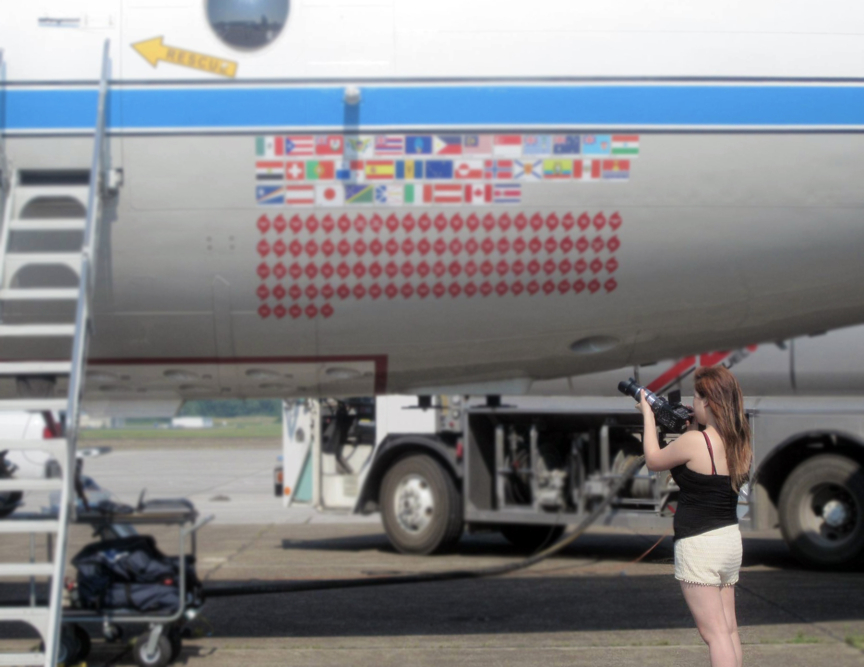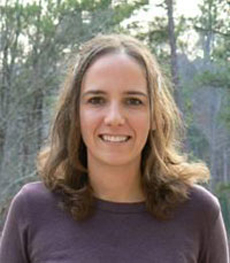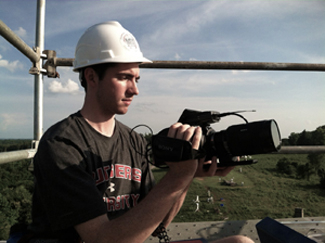Climate expert brings student filmmakers to Alabama to document the mysteries of a cooling forest

:
Ten-year-old Reilly Carlton was unimpressed when his mother told him that Rutgers marine scientists had sent a submersible robot glider across the Atlantic Ocean. “But then I took him to the premiere of Atlantic Crossing at the Zimmerli Art Museum,” Ann Marie Carlton remembered recently. “He was blown away. He was like, ‘Wow! Where’s that glider now? Can we go see it?’”
Her son’s reaction to Atlantic Crossing: A Robot’s Daring Mission sparked an epiphany for Carlton, an atmospheric chemist and assistant professor of environmental sciences at Rutgers. She decided that the power of storytelling through film could help her explain a mystery – why do parts of Alabama, Georgia and Tennessee appear to be warming more slowly than the rest of the United States?
That’s when Carlton turned to the staff and students at Rutgers’ Center for Digital Filmmaking, which produced Atlantic Crossing, to document her own research on climate change.
“I wanted a film for two reasons,” Carlton said. “First, filmmakers are the next generation of journalists; most people get their news from TV. These young filmmakers became very comfortable talking science with me and they forced me to explain esoteric jargon. I hope that stays with them, that they’re never afraid to cover science. And for my work in particular, issues of air quality and climate-change often create interested but misinformed debate, and I think the film will chip away at that.”
Carlton thinks that the southeast’s relatively slow warming is due to several factors: carbon dioxide emitted from trees and plants, combined with gases produced by people, create a sort of insulating haze. Because less light and heat get through, warming is slower.
Dena Seidel, the center’s director, assigned Sean Feuer, Jamie Deradorian-Delia and Stephanie Wong to join Carlton at her research site in Alabama and document her work. They shot their footage during one week in June, and are now editing. They hope to have their film, The Skycatcher, finished by spring.

Carlton set up her research site on the edge of Talladega National Forest in Alabama, because the Electric Power Research Institute already had an air quality station there. EPRI agreed to fund the development of the site and provide it with power.
The filmmakers captured Carlton’s movements as she took air samples with ground-based sensors, weather balloons and sensors attached to airplanes. The documentary will show Carlton working and in her off-hours – playing with her sons, who joined her for the week, and speaking to a local civic club. Carlton is a three dimensional person – a character, in filmmaking terms. The documentary, like all the center’s documentaries, will be “character-driven.”
“All our projects require a complex relationship with the people we’re shooting, and a lot of trust,” Seidel said. Since bringing the center into existence five years ago in the basement of the English Department, Seidel has overseen its growth. The center, a joint program of the School of Arts and Sciences and the Mason Gross School of the Arts, now has 93 students enrolled in its film certificate program, and more than 200 taking classes. Seidel and Mason Gross Dean George Stauffer plan to offer a film major eventually, perhaps as soon as the fall of 2014.
“I wanted to start a film program at Mason Gross from the day I arrived, so when the opportunity to establish the center came up, I jumped at it,” Stauffer said. “What I really like about the program is that Dena and her staff engage the students. They’re not just apprentices; they’re making films.”

The students’ work and travel is funded under Carlton’s National Science Foundation grant, which requires that projects demonstrate a societal benefit, which could include involving students in research or presenting research results to non-scientific audiences.
The experience broadened the students’ horizons. Deradorian-Delia, an English major, enjoyed working with Wong, a visual-arts major, and Feuer, a communications major. “And I got to work with a scientist, which was totally different from what I’m used to,” she said.
Wong enjoyed the six-week preparation, in which the students “tried to predict what situations would come up, and when, and how we would tell the story.” She worried a bit about how an Asian-American from New Jersey would be received in a small southern town, but her worries were unfounded. “People were genuinely nice to us, and curious about what we were doing,” Wong said.
That’s not to say the students didn’t suffer for their art. Feuer spent a day shooting in the airplane that sampled the air at different altitudes. He threw up a lot, but kept shooting. “I thought, ‘Oh, my God, is this going to last for eight hours?’” he remembered. Feuer persevered, got his footage, and won the respect of the plane’s crew.